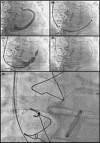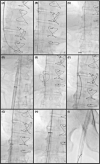Coronary sinus reducer transfemoral extraction after intraprocedural device migration: A case report
- PMID: 33489187
- PMCID: PMC7813095
- DOI: 10.1002/ccr3.3538
Coronary sinus reducer transfemoral extraction after intraprocedural device migration: A case report
Abstract
The coronary sinus reducer migration during implantation procedure is a rare complication with no standard bailout strategy. Transfemoral extraction of the reducer can be a safe and successful method, as demonstrated by this case report.
Keywords: coronary sinus; device migration; reducer; refractory angina; snare; transfemoral extraction.
© 2020 The Authors. Clinical Case Reports published by John Wiley & Sons Ltd.
Conflict of interest statement
Shmuel Banai is the Medical Director of Neovasc, Inc. The other authors have no conflict of interest.
Figures



References
-
- Knuuti J, Wijns W, Saraste A, et al. 2019 ESC Guidelines for the diagnosis and management of chronic coronary syndromes. Eur Heart J. 2020;41(3):407‐477. - PubMed
-
- Konigstein M, Giannini F, Banai S. The Reducer device in patients with angina pectoris: mechanisms, indications, and perspectives. Eur Heart J. 2018;39(11):925‐933. - PubMed
-
- Tzanis G, Palmisano A, Gallone G, et al. The impact of the coronary sinus reducer upon left ventricular function in patients with refractory angina pectoris. Catheter Cardiovasc Interv. 2020;95:1104‐1108. - PubMed
-
- Palmisano A, Giannini F, Rancoita P, et al. Feature tracking and mapping analysis of myocardial response to improved perfusion reserve in patients with refractory angina treated by coronary sinus Reducer implantation: a CMR study. Int J Cardiovasc Imaging. 2020. ahead of print. 10.1007/s10554-020-01964-9 - DOI - PubMed
Publication types
LinkOut - more resources
Full Text Sources

